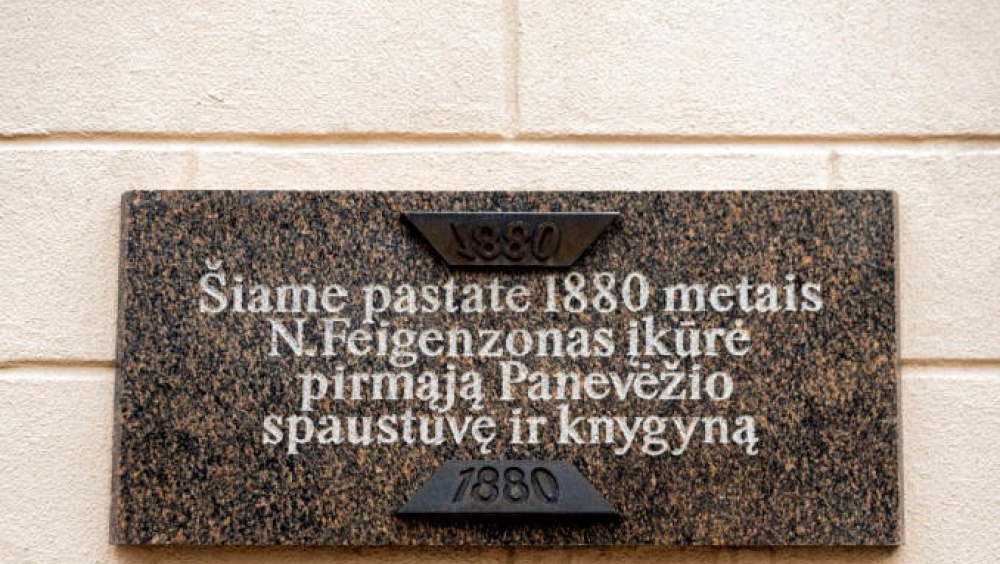First printing house in Panevėžys
Naftalis Feigenzon printing house is the first printing house in Panevėžys establishes in 1880. Feigenzon receives permission to open a bookstore near the printing press. Near the printing house, N. Feigenzon had a bookstore selling some printed brochures and books. Since 1881 the bookstore is already performing library functions. 1886 Mr. Feigenzon is asking to open a reading room for newspapers and books at the bookstore. Naftalis Feigenzon is a great reflection of the Jewish heritage of Europe, which is not very rich in the city. Before the war, Panevėžys was a very Jewish city, there were more Jews than Lithuanians. There is very little survived heritage, so the opportunity to do a storytelling for visitors in a unique building is very important. There are unique tiles that testify the extraordinary architecture of the building. The building of N. Feigenzon's printing house now is a part of Panevėžys County Gabrielė Petkevičaitė-Bitė public Library.
In 1880 Naftalis Feigenzon, a citizen of Ukmergė, asked the Kaunas governor for permission to establish a printing house in Panevėžys. In the summer of the same year, the permit was obtained and the first printing house in Panevėžys was soon opened. It also had lithography machines and was able to carry out various orders. Initially, the company was located in the house of the officers' club on Vilkomirskaya (now Ukmergė) street. She later moved to a building on Dvorianskaya Street (now Respublikos St. 14). 1880 in November, Feigenzon receives permission to open a bookstore near the printing press. N. Feigenzon's printing house printed Panevėžys Duma (parlament) resolutions, government letters, publications of various agencies, associations or institutions, receipts, forms, business cards, labels for the few companies of Panevėžys at that time, programs of events, in Russian, German, French and Jewish. Near the printing house, N. Feigenzon had a bookstore selling some printed brochures and books. Since 1881 the bookstore is already performing library functions. 1886 Mr. Feigenzon is asking to open a reading room for newspapers and books at the bookstore. 1913 N. Feigenzon sells the equipment on Dvorianskaja Street to the printer Morduchas Kotas, and he sets up a printing house in Stein House, Moskovskaja Street (now Panevėžio Bataliono St. 5).
There were more requests to open a printing house in Panevėžys, but the local administration restricted their establishment. According to the Chief of the Panevėžys County Police, at that time one printing house in Panevėžys was enough, so permits for the establishment of other printing houses until 1895. were not issued.
From the publications registered in bibliographic publications, it can be seen that in addition to accreditation works, the printing house also printed periodicals, books and brochures. Before the First World War, several issues of the newspapers Ponevežskij listok and Naš kraj were published. In 1924–1930, the weekly Panevėžys Voice was published. Last discovered print - Lindė-Dobilas, Julijonas. Vincas Kudirka. Panevėžys: 7th grade publication of Panevėžys Men's Gymnasium, 1935
The building of N. Feigenzon's printing house now is a part of Panevėžys County Gabrielė Petkevičaitė-Bitė public Library.
During the tours you can see how printing house is integrated into the library buildings, the printer himself is introduced and the knowledge about his activities can be found in the archival documents. There are unique tiles that testify the extraordinary architecture of the building. Although no machines have survived, the story creates images for visitors about the printed word of that time and its importance.
This first Panevėžys printing house and Naftalis Feigenzon is a great reflection of the Jewish heritage of Europe, which is not very rich in the city. Naftalis Feigenzon not only made a change in the development of the city’s history, but also introduced Jewish culture. Before the war, Panevėžys was a very Jewish city, there were more Jews than Lithuanians. There is very little survived heritage, so the opportunity to do a storytelling for visitors in a unique building is very important.
